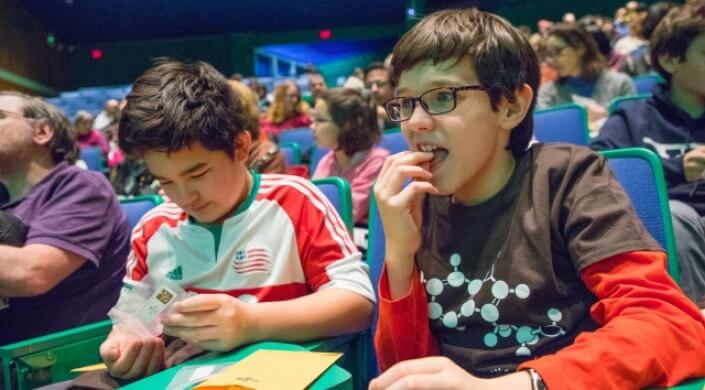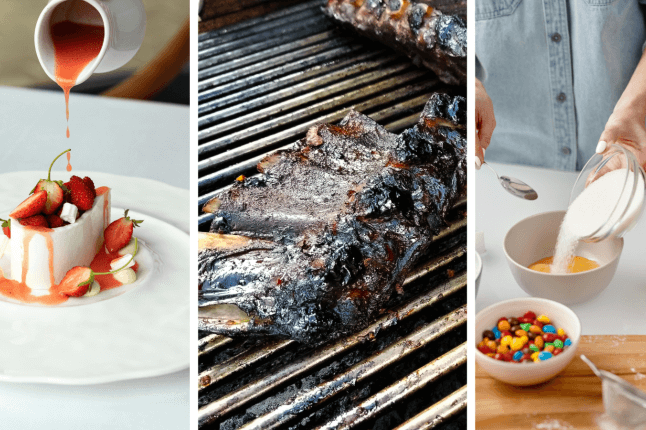News
Isaac Devers, 11, and Rowan Ferguson, 11, of Somerville, measure the diference in melting time between a milk chocolate chip vs. a dark chocolate chip. (Photo by Eliza Grinnell/SEAS Communications)
Combine a Harvard lecture hall full of kids, thousands of chocolates, and simulated scientific experiments and what do you get? The answer: sweet learning at the annual John A. Paulson School of Engineering and Applied Sciences (SEAS) holiday lecture.
On Dec. 10, the Harvard Science Center welcomed hundreds of local families as SEAS and Princeton University presented their holiday science lecture. The presentation, “Hold your Temper: Celebrating the Science of Chocolate,” was led by Howard Stone, a former member of the Harvard faculty and now Dixon Professor in Mechanical and Aerospace Engineering at Princeton University, assisted by Daniel Rosenberg, a chemist and member of the Science Center’s lecture demonstration team.
As children entered the lecture hall, they were offered colored t-shirts representing the different molecular ingredients of chocolate: yellow for cocoa butter; brown for the cocoa bean particles; and white for the amphiphiles, emulsifying molecules that help combine the hydrophobic (water-resisting) butter with the hydrophilic (water-loving) bean. This is confusing vocabulary even for an adult, but Stone would soon help the whole audience understand.
Lorna Servuson (left) expresses her dislike of raw coco beans. (Photo by Eliza Grinnell/SEAS Communications)
Audience members also received “experiment packs” containing four packets of chocolate samples to be examined and, of course, eaten throughout the presentation. The lecture opened by covering the history of chocolate production. Kids and parents were invited to open their first sample pack to taste a real cocoa bean. Stone then turned deeper to the science of chocolate making, using the topic to explain the principles of hydrophilic, hydrophobic, and amphiphilic molecules.
As the audience participated in their first experiment—letting two types of chocolate sit on their tongues—they concluded that dark chocolate melts slower than light chocolate. Stone explained that chocolate, like other substances, has different phases: solid, liquid, and gas. To ensure understanding, children were invited to the front of the room to demonstrate how an atom acts in each phase; countless small bodies were soon wiggling their way around the lecture hall.
Moving on to the texture of chocolate, Stone and Rosenberg displayed scanning electron microscope images that showed granularities within chocolate no wider than a human hair. The audience then compared textures of a grainier Mexican chocolate to a smoother European chocolate.
One young audience member, Aminya Dorsen, enthusiastically declared that she preferred the grainy texture.
Cocoa-powder molecules are hydrophilic—meaning they dissolve in water—while oily cocoa butter molecules are hydrophobic. Getting two such opposite substances to mix requires special molecules called emulsifiers or surfactants. Stone enlists the children in the audience to demonstrate this process. (Photo by Eliza Grinnell/SEAS Communications)
Stone then presented the final lesson: how the mixing and packing of fats and water are combined to form these delicious treats. Kids once again were called to the front and organized by their shirt colors. The children acting as cocoa butter and cocoa beans linked arms with the amphiphile children, as the amphiphilic “head” likes water and the “tail” doesn’t. Thus, it is the right molecule to mix the water-resisting butter and the water-loving beans and provide the rich and smooth taste of chocolate.
Jade Buckwalter, another young audience member, explained what she enjoyed most. “Learning about hydrophobic and hydrophilic molecules, how they’re different and what you do with them to make things,” she said.
Her friend, Mathias George, added: “I liked the learning and the eating,” he said.
Holiday Lecture Demonstration
Watch as the children demonstrate a chemical reaction involved in the chocolate-making process. (Video by Eliza Grinnell/SEAS Communications)
Cutting-edge science delivered direct to your inbox.
Join the Harvard SEAS mailing list.
Press Contact
Adam Zewe | 617-496-5878 | azewe@seas.harvard.edu



